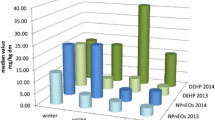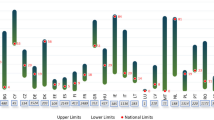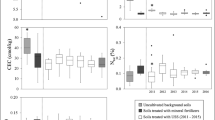Abstract
The application of sewage sludge (SS) in the soil can be a valuable way to increase its content of organic matter. However, the concentration of potentially toxic metal (PTM) in both SS and soil can hinder this route of management. Thus, the main objective of this work was to evaluate the compliance with the restrictions related to PTM contained in SS from wastewater treatment plants (WWTP) for agricultural land application. The regulatory constraints associated with SS and soil in respect to PTM (Cd, Cr, Cu, Ni, Pb, and Zn) were analyzed. These metals showed a deleterious effect on germination of Lepidium sativum seeds, and their phytotoxicity may be ranked as Cd > Cu > Cr(VI) > Cr(III) ~ Zn ~ Ni > Pb. Portuguese SS samples from different WWTP, from a national sludge management operator, and from the literature were considered. The results revealed that the content of these metals, in general, complies with the regulatory threshold values. The content of PTM in the soil is not restrictive to receive SS in at least 90% of the national territory. The assessment of ecological risk based on the geoaccumulation index (Igeo), pollution index (PI), and potential ecological risk index (PERI) showed low risk for all metals. The exception was Igeo of Cd, Cu, and Zn, which presented moderate to high level of pollution. According to the state of the art, no significant negative impacts have been detected on human health and the environment due to SS applications in the soil. Thus, in a country with low carbon content in the land and whenever compliance with regulations is achieved, the main route for SS management may be agricultural soil.






Similar content being viewed by others
References
Alvarenga P, Mourinha C, Farto M, Santos T, Palma P, Sengo J, Morais MC, Cunha-Queda C (2015) Sewage sludge, compost and other representative organic wastes as agricultural soil amendments: benefits versus limiting factors. Waste Manag 40(276):44–52
Alvarenga P, Farto M, Mourinha C, Palma P (2016) Beneficial use of dewatered and composted sewage sludge as soil amendments: behaviour of metals in soils and their uptake by plants. Waste Biomass Valor 7(5):1189–1201
Amaral MAB (2012) Poluição dos solos por metais pesados na zona urbana de Ponta Delgada: implicações na saúde pública. MSc Thesis. University of Azores, Portugal
APA (2013) Gestão de Lamas de Estações de Tratamento de Águas Residuais Urbanas (2010 – 2013), Report from Portuguese Environmental Protection Agency
APA (2017). Gestão de Lamas abrangidas pelo Decreto-Lei n.° 276/2009, Report from Portuguese Environmental Protection Agency.
Bancessi AM (2009) Valorização agronómica/energética de lamas de ETAR: Estudo de caso da ETAR de Beirolas. MSc Thesis. Instituto Superior de Agronomia da Universidade Técnica de Lisboa. Portugal.
Barcelo J, Poschenrieder C (1990) Plant water relations as affected by heavy metal stress: a review. J Plant Nutr 13(1):1–37
Camargo FP, Sérgio Tonello P, dos Santos ACA, Duarte ICS (2016) Removal of toxic metals from sewage sludge through chemical, physical, and biological treatments—a review. Water Air Soil Pollut 227(12):433
Chan WP, Wang JY (2016) Comprehensive characterisation of sewage sludge for thermochemical conversion processes - based on Singapore survey. Waste Manag 54:131–142
Cimochowicz-Rybicka M (2013) Minimization of sewage sludge production – European trends and selected technologies, 99–108. https://www.kth.se/polopoly_fs/1.651120!/JPSU18P12.pdf. Accessed 15 June 2018.
Cole LJ, McCracken DI, Foster GN, Aitken MN (2001) Using Collembola to assess the risks of applying metal-rich sewage sludge to agricultural land in western Scotland. Agric Ecosyst Environ 83(1–2):177–189
Collard M, Teychené B, Lemée L (2017) Comparison of three different wastewater sludge and their respective drying processes: solar, thermal and reed beds - impact on organic matter characteristics. J Environ Manag 203:760–767
COM (2017) Report from the Commission to the European Parliament, the Council, the European Economic and Social Committee and the Committee of the Regions on the implementation of EU waste legislation for the period 2010-2012.
CONAMA (2006) Resolução Conama 375/2006. Define critérios e procedimentos, para o uso agrícola de lodos de esgoto gerados em estações de tratamento de esgoto sanitário e seus produtos derivados, e dá outras providências. Ministério do Meio Ambiente, Brazil. Diário Oficial da União, 1–32.
Das P, Samantaray S, Rout GR (1997) Studies on cadmium toxicity in plants: a review. Environ Pollut 98(1):29–36
Di Maria F, Micale C (2017) Energetic potential of the co-digestion of sludge with bio-waste in existing wastewater treatment plant digesters: a case study of an Italian province. Energy 136:110–116
Dimitriou I, Eriksson J, Adler A, Aronsson P, Verwijst T (2006) Fate of heavy metals after application of sewage sludge and wood-ash mixtures to short-rotation willow coppice. Environ Pollut 142(1):160–169
Duan B, Zhang W, Zheng H, Wu C, Zhang Q, Bu Y (2017) Disposal situation of sewage sludge from municipal wastewater treatment plants (WWTPs) and assessment of the ecological risk of heavy metals for its land use in Shanxi, China. Int J Environ Res Public Health, 14(7): 1-12.
ECWD (2000) European Commission working document on sludge. 3rd draft ENVE3/LM, 27 April 2000.
Eriksson J (2001) Concentrations of 61 trace elements in sewage sludge, farmyard manure, mineral fertiliser, precipitation and in oil and crops. Swedish Environmental Protection Agency, Stockholm, Sweden. http://www.naturvardsverket.se/documents/publikationer/620-6246-8.pdf. Accessed 12 June 2018.
Evans TD (2016) Sewage sludge: operational and environmental issues FR/R0001 - review of current knowledge. Foundation for Water Research (4a., Vol. Fourth Edi). U.K.
Fan-xin Q, Chao-fu W, Shou-qin Z, Xian-fei H, Wen-pin P, Xin J (2016) Soil heavy metal(loid)s and risk assessment in vicinity of a coal mining area from southwest Guizhou, China. J Cent South Univ 23:2205–2213
Fernández JM, Hernández D, Plaza C, Polo A (2007) Organic matter in degraded agricultural soils amended with composted and thermally-dried sewage sludges. Sci Total Environ 378(1–2):75–80
Fijalkowski K, Rorat A, Grobelak A, Kacprzak MJ (2017) The presence of contaminations in sewage sludge – the current situation. J Environ Manag 203:1126–1136
Fu F, Wang Q (2011) Removal of heavy metal ions from wastewaters: a review. J Environ Manag 92(3):407–418
Fuentes A, Lloréns M, Sáez J, Aguilar MI, Pérez-Marín AB, Ortuño JF, Meseguer VF (2006) Ecotoxicity, phytotoxicity and extractability of heavy metals from different stabilised sewage sludges. Environ Pollut 143(2):355–360
Fytili D, Zabaniotou A (2008) Utilization of sewage sludge in EU application of old and new methods - a review. Renew Sust Energ Rev 12(1):116–140
Gomes LA; Gando-Ferreira L; Góis JC, Quina MJ (2018) Aplicação de lamas de ETAR urbanas no solo Português e as restrições associadas aos metais pesados, Proc. CIALP- Conferência Internacional de Ambiente em Língua Portuguesa, Vol. II, pg 12-21, 8-10 maio, Aveiro, Portugal
González I, Serrano A, García-Olmo J, Carmen Gutiérrez M, Chica AC, Martín MA (2017) Assessment of the treatment , production and characteristics of WWTP sludge in Andalusia by multivariate analysis. Process Saf Environ Prot 9(I09):609–620
Gustafsson JP, Mwamila LB, Kergoat K (2012) The pH dependence of phosphate sorption and desorption in Swedish agricultural soils. Geoderma 189–190:304–311
Healy MG, Fenton O, Forrestal PJ, Danaher M, Brennan RB, Morrison L (2016) Metal concentrations in lime stabilised, thermally dried and anaerobically digested sewage sludges. Waste Manag 48:404–408
Herzel H, Krüger O, Hermann L, Adam C (2016) Sewage sludge ash - a promising secondary phosphorus source for fertilizer production. Sci Total Environ 542:1136–1143
Inácio M, Pereira V, Pinto M (2008) The soil geochemical Atlas of Portugal: overview and applications. J Geochem Explor 98:22–33
Inglezakis VJ, Zorpas AA, Karagiannidis A, Samaras P, Voukkali I, Sklari S (2014) European Union legislation on sewage sludge management. Fresenius Environ Bull 23(2 A):635–639
Jiang RF, Ma DY, Zhao FJ, Mcgrath SP (2005) Cadmium hyperaccumulation protects Thlaspi caerulescens from leaf feeding damage by thrips (Frankliniella occidentalis). New Phytol 167(3):805–814
Kahapanagiotis NK, Lester JN, Steheitt RM (1991) Heavy metal complexation in sludge-amended soil. The role of organic matter in metal retention. Environ Technol 12(12):1107–1116
Ke X, Gui S, Huang H, Zhang H, Wang C, Guo W (2017) Ecological risk assessment and source identification for heavy metals in surface sediment from the Liaohe River protected area, China. Chemosphere 175:473–481
Kelessidis A, Stasinakis AS (2012) Comparative study of the methods used for treatment and final disposal of sewage sludge in European countries. Waste Manag 32(6):1186–1195
Kirchmann H, Börjesson G, Kätterer T, Cohen Y (2017) From agricultural use of sewage sludge to nutrient extraction: A soil science outlook. Ambio 46(2):143–154
Kleemann R, Chenoweth J, Clift R, Morse S, Pearce P, Saroj D (2017) Comparison of phosphorus recovery from incinerated sewage sludge ash (ISSA) and pyrolysed sewage sludge char (PSSC). Waste Manag 60(5):201–210
Kołecka K, Gajewska M, Obarska-Pempkowiak H, Rohde D (2017) Integrated dewatering and stabilization system as an environmentally friendly technology in sewage sludge management in Poland. Ecol Eng 98:346–353
Kruger O, Grabner A, Adam C (2014) Complete survey of German sewage sludge ash. Environ Sci Technol 48(20):11811–11818
Lal R (2003) Global potential of soil carbon sequestration to mitigate the greenhouse effect. Crit Rev Plant Sci 22(2):151–184
LeBlanc RJ, Matthews P, Richard RP (2008) Global Atlas of excreta, wastewater sludge, and biosolids management: moving forward the sustainable and welcome uses of a global resource. (R. P. R. Ronald J. LeBlanc, Peter Matthews and Graphic, Eds.)Un-Habitat. Kenya.
Lopes JVS (2017) Análise e melhoria dos processos de gestão de lamas de depuração de efluentes líquidos Analysis and improvement of the management system of sewage sludge. MSc Thesis. University of Coimbra, Portugal.
Loska K, Wiechulła D, Korus I (2004) Metal contamination of farming soils affected by industry. Environ Int 30(2):159–165
Mailler R, Gasperi J, Patureau D, Vulliet E, Delgenes N, Danel A, Deshayes S, Eudes V, Guerin S, Moilleron R, Chebbo G, Rocher V (2017) Fate of emerging and priority micropollutants during the sewage sludge treatment: case study of Paris conurbation. Part 1: contamination of the different types of sewage sludge. Waste Manag 59:379–393
Marchioretto MM (2003) Heavy metals removal from anaerobically digested sludge. Thesis Wageningen University, (February), 142.
Mattsson A, Finnson A, I’Ons D (2017) Heavy metal content of Swedish municipal wastewater sludge - status and goals. Water Sci Technol 76(4):869–876
Mendes S (2014) Valorização de lamas de tratamento de águas residuais urbanas para utilização agrícola. MSc thesis. Instituto Superior de Engenharia de Lisboa, Portugal.
Milik J, Pasela R, Lachowicz M, Chalamoński M (2017) The concentration of trace elements in sewage sludge from wastewater treatment plant in Gniewino. Journal of Ecological Engineering 18(5):118–124
Mininni G, Blanch AR, Lucena F, Berselli S (2015) EU policy on sewage sludge utilization and perspectives on new approaches of sludge management. Environ Sci Pollut Res 22(10):7361–7374
Mosquera-Losada R, Amador-García A, Muñóz-Ferreiro N, Santiago-Freijanes JJ, Ferreiro-Domínguez N, Romero-Franco R, Rigueiro-Rodríguez A (2017) Sustainable use of sewage sludge in acid soils within a circular economy perspective. Catena 149:341–348
Munzuroglu O, Geckil H (2002) Effects of metals on seed germination, root elongation, and coleoptile and hypocotyl growth in Triticum aestivum and Cucumis sativus. Arch Environ Contam Toxicol 43(2):203–213
Olofsson U, Bignert A, Haglund P (2012) Time-trends of metals and organic contaminants in sewage sludge. Water Res 46(15):4841–4851
Ozdener Y, Kutbay HG (2009) Toxicity of copper, cadmium, nickel, lead and zinc on seed germination and seedling growth in Eruca sativa. Fresenius Environ Bull 18(1):26–31
Panepinto D, Fiore S, Genon G, Acri M (2016) Thermal valorization of sewer sludge: perspectives for large wastewater treatment plants. J Clean Prod 137:1323–1329
Pathak A, Dastidar MG, Sreekrishnan TR (2009) Bioleaching of heavy metals from sewage sludge: a review. J Environ Manag 90(8):2343–2353
Pavel LV, Sobariu DL, Diaconu M, Stătescu F, Gavrilescu M (2013) Effects of heavy metals on Lepidium sativum germination and growth. Environ Eng Manag J 12(4):727–733
Pinho IA, Lopes DV, Martins RC, Quina MJ (2017) Phytotoxicity assessment of olive mill solid wastes and the influence of phenolic compounds. Chemosphere 185:258–267
Praspaliauskas M, Pedišius N (2017) A review of sludge characteristics in Lithuania’s wastewater treatment plants and perspectives of its usage in thermal processes. Renew Sust Energ Rev 67:899–907
Quina MJ, Soares MAR, Quinta-Ferreira R (2017) Applications of industrial eggshell as a valuable anthropogenic resource. Resour Conserv Recycl 123:176–186
RARSAP (2016) Relatório Anual dos Serviços de Águas e Resíduos em Portugal. Entidade Reguladora dos Serviços de Águas e Resíduos. (Entidade Reguladora dos Serviços de Águas e Resíduos, Ed.) (2016th ed., Vol. 1). Portugal.
Rieuwerts JS, Thornton I, Farago ME, Ashmore MR (1998) Factors influencing metal bioavailability in soils: preliminary investigations for the development of a critical loads approach for metals. Chem Speciat Bioavailab 10(2):61–75
Rizzardini CB, Goi D (2014) Sustainability of domestic sewage sludge disposal. Sustainability (Switzerland) 6(5):2424–2434
Roig N, Sierra J, Nadal M, Martí E, Navalón-Madrigal P, Schuhmacher M, Domingo JL (2012) Relationship between pollutant content and ecotoxicity of sewage sludges from Spanish wastewater treatment plants. Sci Total Environ 425:99–109
Saxena V, Nielsen J (2004) Novel integrated bio-optical system for oxygen saturation measurement. In M. J. Yaffe and M. J. Flynn (Eds.), 1996 (p. 255).
Serrão MG, Varela A, Fareleira P, Branco MAC, Fernandes M, Martins J, Pires F, Ramos JB, Monteiro O, Dordio A (2009) Fertilidade e contaminação por metais pesados e microrganismos fecais de um solo sob pastagem pela aplicação de lama residual urbana. Revista de Ciências Agrárias 32:273–283
Shahid M, Shamshad S, Rafiq M, Khalid S, Bibi I, Niazi NK, Dumat C, Rashid M (2017) Chromium speciation, bioavailability, uptake, toxicity and detoxification in soil-plant system: a review. Chemosphere 178:513–533
Sharma B, Sarkar A, Singh P, Singh RP (2017) Agricultural utilization of biosolids: a review on potential effects on soil and plant grown. Waste Manag 64:117–132
Smilde KW (1981) Heavy-metal accumulation in crops grown on sewage sludge amended with metal salts. Plant Soil 62(1):3–14
Spinosa L, Ayol A, Baudez J-C, Canziani R, Jenicek P, Leonard A, Rulkens W, Xu G, van Dijk L (2011) Sustainable and innovative solutions for sewage sludge management. Water 3(4):702–717
Sousa RJV (2005) Estratégias de gestão de lamas das Estações de Tratamento de Águas Residuais (ETAR). Extrusão de lamas para aplicação na agricultura. MSc Thesis. Universidade do Porto, Portugal.
Stefanakis AI, Tsihrintzis VA (2012) Heavy metal fate in pilot-scale sludge drying reed beds under various design and operation conditions. J Hazard Mater 213–214:393–405
Taylor S, McLennan S (1995) The geochemical evolution of the continental crust. Rev Geophys 33(2):241–265
Tóth G, Hermann T, Da Silva MR, Montanarella L (2016) Heavy metals in agricultural soils of the European Union with implications for food safety. Environ Int 88:299–309
U.S. EPA. Code of Federal Regulations Title 40, Part 503. U. S. Environmental Protection Agency. (1993).
Urbaniak M, Wyrwicka A, Tołoczko W, Serwecińska L, Zieliński M (2017) The effect of sewage sludge application on soil properties and willow (Salix sp.) cultivation. Sci Total Environ 586:66–75
USEPA (2001) Method 1683 total, fixed and volatile, solids and biosolids. Science And Technology, EPA-821-R-(January), 13.5
Veeken AHM, Hamelers HVM (1999) Removal of heavy metals from sewage sludge by extraction with organic acids. Water Sci Technol 40(1):129–136
Visioli G, Menta C, Gardi C, Conti FD (2013) Metal toxicity and biodiversity in serpentine soils: application of bioassay tests and microarthropod index. Chemosphere 90(3):1267–1273
Wiechmann B, Dienemann C, Kabbe C, Brandt S, Vogel I, Roskosch A (2013) Sewage sludge management in Germany. Umweltbundesamt (UBA), Germany
Acknowledgments
The authors gratefully acknowledge Federal Institute of Education, Science, and Technology of Brasília - IFB, Campus Ceilândia, for authorizing the Ph.D. studies of Luciano A. Gomes and SS Bioenergias for providing the reports about soil and SS samples.
Funding
This work was developed under the project “Dry2Value - Estudo e desenvolvimento de um sistema de secagem para valorização de lamas”. Project consortium with HRV e LenaAmbiente. POCI-01-0247-FEDER-033662, funded by Fundo Europeu de Desenvolvimento Regional (FEDER) - Programa Operacional Competitividade e Internacionalização.
Author information
Authors and Affiliations
Corresponding author
Additional information
Responsible editor: Severine Le Faucheur
Publisher’s note
Springer Nature remains neutral with regard to jurisdictional claims in published maps and institutional affiliations.
Electronic supplementary material
ESM 1
(DOCX 135 kb)
Rights and permissions
About this article
Cite this article
Gomes, L.A., Gabriel, N., Gando-Ferreira, L.M. et al. Analysis of potentially toxic metal constraints to apply sewage sludge in Portuguese agricultural soils. Environ Sci Pollut Res 26, 26000–26014 (2019). https://doi.org/10.1007/s11356-019-05796-6
Received:
Accepted:
Published:
Issue Date:
DOI: https://doi.org/10.1007/s11356-019-05796-6




